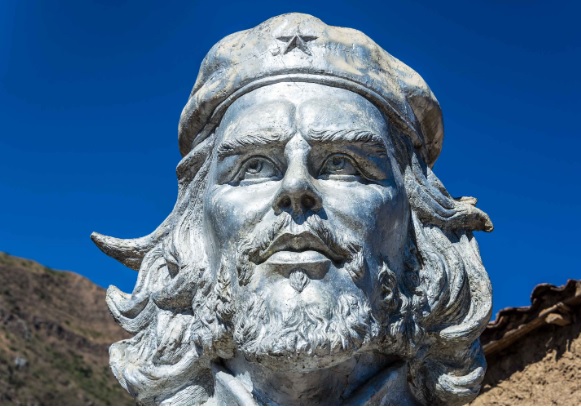Ernesto Guevara: The Great Revolutionary
Ernesto Guevara was a great Cuban Revolutionary who was born in June, 1928 in Santa Fe, Argentina. He did a lot in his short life of just 39 years. He was assassinated by the Central Criminal Agency (CIA) while in Bolivia. He played a large number of roles in life. He was an author, physician and government official.
Guevara worked for Cuban Socialist Revolution and National Liberation Army in Bolivia as a mercenary. In 1955, he married Hilda Gadea and later after 1959 he was married to Aleida March.
Guevara was simply known as Che. He had a variety of skills in diplomacy, guerrilla warfare and military theory. In many places around the world he is regarded as a symbol of rebellion.
Che Guevara had witnessed a lot of poverty, disease and hunger while he traveled as a medical student in South America. He therefore developed a burning desire to help change the situation which was brought about by the capitalistic exploitation by the USA.
Guevara met Fidel and Raul Castro in Mexico City when he was staying there. These two men helped him to solidify his political ideology. He sailed to Cuba to assist in the overthrow of Fulgencio Batista who was the Cuban Dictator. Guevara worked hard and was made the second-in-command among the insurgents. The struggle continued for two years before they defeated the dictatorial regime.
After the revolution, Guevara was in charge of reviewing the appeals of war criminals that were to face the firing squad. This is the time when the agrarian land reforms were put in place. He also helped in the leading a successful literacy campaign nationwide. He served as the instructional director of Cuba armed forces as well as the president of the national bank. Finally, he traveled around the globe promoting Cuban socialism.
Guevara was a prolific writer and diarist. He wrote a manual on guerrilla warfare in addition to an award winning memoir based on his continental motorcycle journey while he was a youth.
In 1965, Guevara left Cuba to help rebels in Congo and then Bolivia where he was arrested by the CIA and later killed.
Guevara is a revered historical figure. His life has been recorded in a number of essays, books, memoirs, documentaries, films and even songs. His execution is perceived by many as martyrdom for his class struggle for freedom. Guevara was a great man who was never driven by material incentives. He was always motivated by moral incentives in life.
Guevara was the eldest of the five children of Ernest Guevara Lynch and Celia de la Sema. Che was a restless child. That is why his father always said that there was some Irish rebel blood flowing in the veins of Guevara. While he was young Che developed an affinity for the poor people in the society.
While he was growing, his family had a leftist leaning. He got a view of a large number of political perspectives while he was young. His father was an active supporter of the Republicans originating from the Spanish Civil wars. The father was a host of many war veterans.
He was suffering from asthma that afflicted him throughout his life. He was a great swimmer, athlete, golfer and shooter. He played for the Rugby Union. He earned the name ‘fuser’ from his playing of rugby.
He was very passionate about poetry since his adolescence times and throughout his life. His home contained over 3,000 books which Guevara read enthusiastically. His most popular authors were: Karl Marx, Jules Verne, Andre Gide, William Faulkner and Emilio Salgari. He also liked to read the books by Vladimir Lenin, Franz Kafka, Jean-Paul Sarte and Albert Camus.
He always cataloged ideas by Latin American writers in his handwritten notebooks. He wrote down the concepts, philosophies and definitions of the influential thinkers.
The CIA noted that Guevara had a wide range of academic interests. They described his as a well read man. They even added that Che Guevara is fairly intellectual for a Latino.
Che Guevara attended the University of Buenos Aires where he studied medicine. He had a desire to explore the world. He made two motorcycle journeys that changed the way he saw life in Latin America. The first journey was 4,500 kilometers long. He traveled alone on a bicycle with a small engine. Then, in 1951 he started another journey which lasted for nine months. It covered 8,000 kilometers through most of South America. It was a continental motorcycle trip. This journey made him to take a year off from his medical studies. He traveled with his friend Alberto Granado. As they traveled, they helped treat people whom they met on the way. Guevara used the notes that he wrote while travelling to write The Motorcycle Diaries. This book later became the best seller at the New York Times. It was later adapted into an award-winning film with the same name.
The nine (9) months journey took Guevara through Colombia, Ecuador, Chile, Argentina, Peru, Panama, Venezuela and USA. He spent 20 days in Florida and Miami. He then returned home to Buenos Aires, Argentina.
During these journeys, he discovered that the Latin American countries were faced with a lot of poverty, disease and hunger. These are some of the factors which help Che to change his career from medicine to politics in order to bring change to the state of affairs in the world.
While in Guatemala he witnessed the land reforms adopted by the president which was trying to distribute all the uncultivated land among the peasants. The biggest landowner who was affected by the reforms was the United Fruit Company. By the time Guevara arrived in Guatemala, the government had taken 225,000 acres of all uncultivated land. This land reforms were of great interest to him. He even decided to stay for some time so that he can study the reforms well.
Ernesto Guevara joined the 26th of July Movement. He was supposed to work as a combat medic, but he joined the military training. He participated in the hit and run tactics of guerrilla warfare. The training involved 15-hour marches across rivers, mountains as well as through dense undergrowth. He learnt the techniques of quick ambush followed by retreat.
During the training Che Guevara received the highest marks in all tests during the training. At the end of the training, he became the best of them all in guerrilla tactics. Their instructor was general Bayo.
Castro had great revolutionary plans. On the top of which was to attack Cuba from Mexico on board of an old cabin cruiser called Gramma. They were attacked by Batista’s military immediately on landing in Cuba. He had 82 men in his side. Many of them were killed during the attack or after being captured. It was only 22 people who survived after that brutal attack by Batista. It was during this ferocious attack that Guevara laid down his medical supplies and picked weapons dropped by a comrade who was running away. This marked the transition from medical to combatant life.
The survivors formed a small fighting force in Sierra Maestra Mountains. These people received a lot of support from the urban guerrilla network as well as from the local campesinos.
Guevara was trusted by Castro because of his competence, patience and diplomacy. He helped set up factories to make grenades, taught new recruits on guerrilla tactics, built ovens to bake bread, set up schools to teach the natives on how to read and write, established healthcare facilities, workshops teaching military techniques and a newspaper to pass information. After three years of work, he was nicknamed as ‘Castro’s brains’. As a result of his efforts, he was promoted into the post of a commander (Comandante).
As a comandante he was very hash in dispensing discipline. He would actually shoot defectors. He was feared for being brutal and ruthless in his actions. He was responsible for summary execution of all people who were found to be informers or spies.
Guevara was a great believer in literacy without borders. That is what made him to ensure that his rebel fighters dedicated time on a daily basis to teach campesinos on how to read and write. These are the people with whom they lived. This was the battle against ignorance. Some rebels who worked under Che Guevara said that he was loved despite of being harsh and very demanding.
Guevara played a great role in establishing a radio station called Rebel Radio. This was in 1958 and its role was to broadcast to the Cuban people. It also provided the required radiotelephone communication services to the rebels. The CIA supplied radio services in Guatemala inspired the establishment of this radio station.


